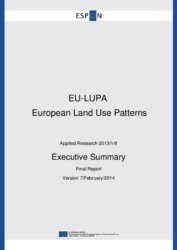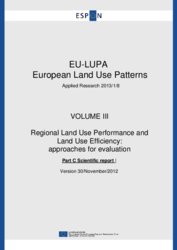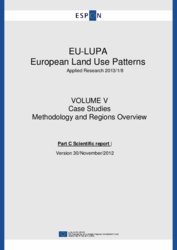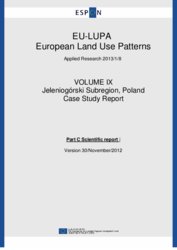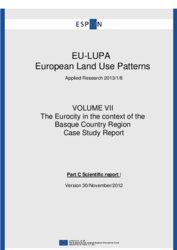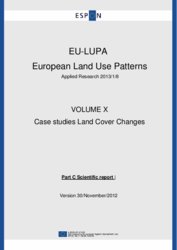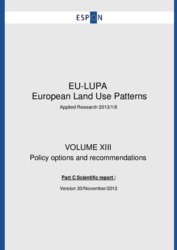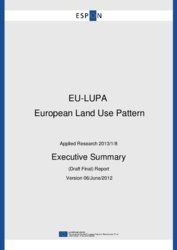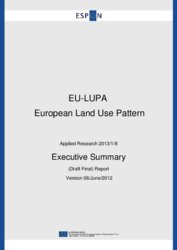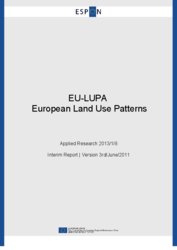EU-LUPA - European Land Use Patterns
Main focus
Land use has changed drastically during the last fifty years (ESA SP 2006) sometimes with important negative effects such as urban sprawl, soil sealing, loss of biodiversity, soil erosion, soil degradation, floods or desertification. The type of land use change varies among different types of regions.
Based on the hypothesis that socio-economic activities are reflected in land use the project understands land use as how the land is used and how it is related to socio-economic activities. This means that at a single point multiple uses can be present.
Until now, land use and land use change in Europe have been mainly addressed from a thematic perspective. There is a need to integrate all these different sector views. Land use characteristics are becoming increasingly multi-functional, crossing not only sectors but also administrative borders. Thus, the objective of the project is to develop a consistent methodology for analysing comparable information about European regions and cities, based on data from different sources and at different levels.
Moreover, the project aims to supply regionalised information integrating the physical dimension (land cover) with socio-economic (land use) and environmental dimensions, in order to understand land use dynamics, land use changes and current land use patterns in the European territory, identifying main challenges in different types of territories, regions and cities and defining the policy recommendations to cope with the challenges.
Please read more about the main research areas and main results envisaged on the next page.
Lead Partner
Labein-Tecnalia-Technology Centre, Spain
Detailed information on the contracted project team can be found under Transnational Project Groups.
Sounding Board
Alma Zavodnik Lamovsek, Slovenia
Daniel Kampus, Austria
Budget: € 788 668.00
Project’s lifetime: July 2010- April 2013
Delivery of Reports
Inception Report: 03 December 2010
Interim Report: 03 June 2011
Draft Final Report: 01 June 2012
Final Report: 05 October 2012
Publishing
Reports will be published once they are approved by the ESPON Monitoring Committee
More information
Please contact the Project Expert at the ESPON Coordination Unit:
Marjan VAN HERWIJNEN, e-mail: marjan.vanherwijnen@espon.eu
Main research areas
- Current European land use patterns and land use changes, dynamics and trends over the last 16 years (1990-2000-2006) as well as the driving forces behind.
- Assessment of to what extent existing land use patterns throughout Europe are in line with the general spatial development principles and how this picture will look like if no extra policy action is taken and new territorial dynamics come into play
- Relations between land use patterns (and more specifically urban land use patterns) and drivers of development such as geographical, demographic and cultural influences, climate change, transport, employment, GDP and other economic structures
- Efficiency of land use patterns efficient in relation to these aspects taking into account the relations between urban areas and open space (non-build areas)
- Assessment of the land use development and land use patterns in particular types of regions
- Evaluation of how these developments can (e.g. through cooperation initiatives) be coordinated and create a development potential.
Main results envisaged
- Identification of scope of existing spatial data and information related to the aspects of land use (urban, non-urban, rural, natural, etc.), land use patterns, land use change (dynamics and trends) and policy-relevant typologies
- Methods of measuring and monitoring land use processes (data and indicators development)
- Input to the ESPON database (data, indicators, typologies)
- Maps visualizing land use processes in Europe in different administrative levels (European, national, regional and local): where are the areas of urban land use and fragmentation, connected areas and stepping stones for rural land use and high quality open space? Mapping European land use patterns and land use change
- Relations between specific land use patterns and performance of European regions, between urban areas and open space at a certain distance, between urban sprawl and specific features (e.g. mountains) and between land use efficiency and aspects such as population, transport, employment, GDP and how can these relations be measured and visualised and which of
these relations are suitable to use in territorial research at European scale - Spatial distribution and specifications of land use development patterns in cross-border regions and the differences between patterns inside neighbouring cross-border regions and between border regions and inland
